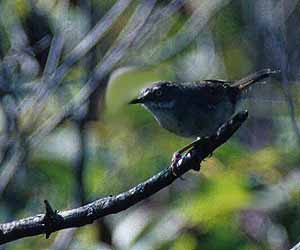
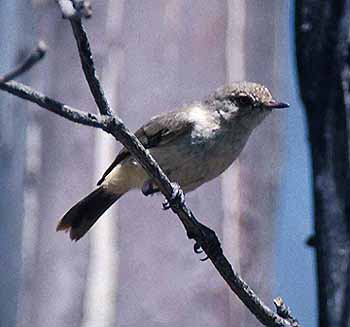 The Acanthizidae is primarily an Australasian family composed of thornbills,
scrubwrens, and gerygones. It also includes three white-faces and a couple
odd ground-dwelling species (Sibley & Alquist 1990). Many are small
arboreal warblers like the Buff-rumped Thornbill (left). It is common
in eucalyptus woodlands of Australia, and several other similar species
of thornbills are widespread, causing visiting birders headaches to sort
out. Differences in eye color and forehead pattern must be noted, and rump
patches can be very hard to see on tiny backlit birds in the canopy. Thornbills
are tiny creatures and often occur in loose flocks; I was reminded of Bushtits
Psaltriparus
minimus from California (although thornbills are a tad larger). Two
Australian acanthizids are ground-dwellers: the Pilotbird
Pycynoptilus
floccosus, which hunts on the rainforest floor and recalls logrunners,
and the rock-loving Origma (or Rock Warbler; below right). The latter
reminded me of Rock Wrens Salpinctes obsoletus in its behavior and
habitat choice.
The Acanthizidae is primarily an Australasian family composed of thornbills,
scrubwrens, and gerygones. It also includes three white-faces and a couple
odd ground-dwelling species (Sibley & Alquist 1990). Many are small
arboreal warblers like the Buff-rumped Thornbill (left). It is common
in eucalyptus woodlands of Australia, and several other similar species
of thornbills are widespread, causing visiting birders headaches to sort
out. Differences in eye color and forehead pattern must be noted, and rump
patches can be very hard to see on tiny backlit birds in the canopy. Thornbills
are tiny creatures and often occur in loose flocks; I was reminded of Bushtits
Psaltriparus
minimus from California (although thornbills are a tad larger). Two
Australian acanthizids are ground-dwellers: the Pilotbird
Pycynoptilus
floccosus, which hunts on the rainforest floor and recalls logrunners,
and the rock-loving Origma (or Rock Warbler; below right). The latter
reminded me of Rock Wrens Salpinctes obsoletus in its behavior and
habitat choice.
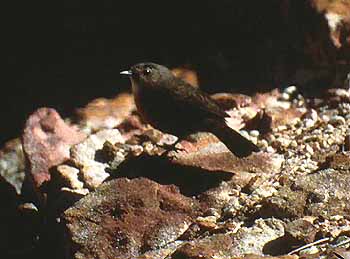
Other acanthizids include three mouse-warblers Crateroscelis
which are skulking, often mouse-like birds in the forest understory in
New Guinea, and very difficult to see without a tape of their lovely songs;
the equally skulking and difficult Fernwren Oreoscopus gutturalis
which is endemic to the Atherton tablelands of northeast Australia; and
13 scrubwrens which are small gregarious LBJs ("little brown jobs") that
mostly crawl about in thickets and can be very difficult to identify. Most
are found in New Guinea, but several exist in Australia, including the
White-browed
Scrubwren (below left).

One of my favorite bird names in English is the Perplexing Scrubwren Sericornis virgatus. Before birding in New Guinea, I enjoyed reading all about the strange taxonomic history of this bird in Diamond (1972). The Perplexing Scrubwren (in the mountains) and Beccari's Scrubwren S. beccarii (in the lowlands) "include a confusing group of populations among which the species limits are not fully clear," wrote Diamond. They are still unclear; Coates (1990) lumps them within a single species. However, must recent writers separate them into at least a montane and a lowland species, but there are 11 racial varieties and the limits are still unknown. I was very pleased to actually see a Perplexing Scrubwren in riverine scrub at the edge of a native village high in the Arfak Mountains of Irian Jaya, New Guinea (not that I have anything to add to the puzzle)....
The most widespread acanthizids are the 17 gerygones (of the genus Gerygone, members of which are called "warblers" or "fairy warblers" in Australia and sometimes elsewhere). These are small arboreal birds, usually in the canopy or sub-canopy, which sometimes feed by hover-gleaning (like kinglets). Some are mangrove specialists; others inhabit arid habitats in the interior of Australia. Three gerygones reach the Sunda Is., Indonesia, including the Golden-bellied Gerygone (below left) which is often called "the Flyeater" there (and it does snatch insects with that broad bill). Another gerygone reaches New Caledonia & the Solomon Is., and two more are extant in New Zealand (with two others extinct there). The common New Zealand gerygone is the Gray Gerygone (below right) but Kiwi locals call it the "Gray Warbler."
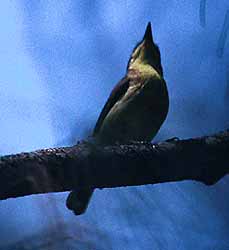
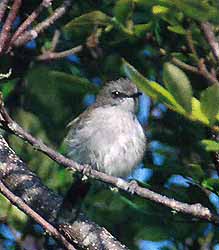
Photos: The Buff-rumped ThornbillAcanthiza reguloides (top left) was photographed on Gulpa Island, New South Wales, Australia, on 31 Dec 1997. The OrigmaOrigma solitaria was in Royal Nat'l Park, just south of Sydney, Australia, on 21 Sep 1983. The White-browed ScrubwrenSericornis frontalis was also in Royal Nat'l Park, but nearly 15 years later in Jan 1998. The Golden-bellied Gerygone Gerygone sulphurea was on the tiny islet of Pulau Rambut, offshore from Jakarta, Java, Indonesia, on 25 Aug 1988. The Gray GerygoneG. igata was along the Whakapapanui River, North Island, New Zealand, on 27 Dec 1997. All photos © D. Roberson.
Bibliographic notes
There is no "family book" covering the Acanthizidae, but outstanding photographs and information about Australian and New Guinea species are found in Frith (1979) and Coates (1990), respectively.
Literature cited:
Coates, B. J. 1990. The Birds of Papua New Guinea. Part II. Dove Publ., Ltd., Alderley, Australia.TOPDiamond, J. M. 1972. Avifauna of the Eastern Highlands of New Guinea. Publ. Nuttall Ornith. Club 12, Cambridge, MA.
Frith, H. J., consulting ed. 1979. The Reader's Digest Complete Book of Australian Birds. 2d revised ed. Reader's Digest Services, Ltd., Sydney.
Sibley, C. G., and J. E. Alquist. 1990. Phylogeny and Classification of Birds: A Study in Molecular Evolution. Yale Univ. Press, New Haven, CT.